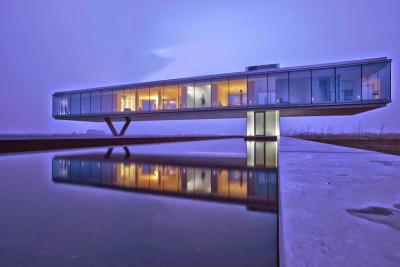Tension in Design - Pure Design versus Practicality
Primary tabs
 I ran across this image today, from David Getts. The image is his and I'm using it out of Fair Use to discuss the concept.
I ran across this image today, from David Getts. The image is his and I'm using it out of Fair Use to discuss the concept.
I suppose it's important to separate the photo from the design. The photo, or I suppose I should more properly call it a render, is dramatic in composition, lighting and setting. The image itself is a great image. But what of the design?
I'm not one to eschew whimsy or the breaking of conventions in design. In fact, I love such things in general. Such things, after all, are why I love the Muppets and the work of Antoni Gaudi and Frank Gehri. But as the son of a dairy farmer, my eye always runs up against something else . . . does it make sense in the real world? Will it work if I had to use it?
This is a case where I suspect the design has overwhelmed the reason for the building. By calling it a home, the designer short circuits a case where it might be practical . . . as an office or museum. But as a home, the design suffers from a couple of crippling practical flaws. The key to this design, the negative space between the ground and the structure, means that it would either be a) cold or b) incredibly energy inefficient. The biggest passive tool for energy efficiency is to use the thermal load of the ground to even out the temperature in a structure. But this home is insulated from the ground. And there is nothing to stop heat loss from all of that surrounding glass. Which brings up the second issue.
The other flaw I see is both practical and a matter of design aesthetic. I see it often in 'modernist' design today. What of privacy? Yes, the setting and furnishings are supplied to increase the interest in the design, but if this home had curtains or opaque coverings, wouldn't it take away much of the interest? Perhaps louvers, which could add texture and privacy? A home rarely sits in a stark landscape such as this. If it does, that still doesn't prevent someone with a telescope from viewing in from a great distance. That's the practicality. But in a design sense, this fails one of the key aspects of home design that I prefer . . . private edges. What we have here is the entire edge of the home being a public display area, with the private hideaways presumably being tucked in the middle. It seems fragile, and needy. This is a home for not merely an extrovert, but an exhibitionist. Still, there are people who are such, and I suppose this would suit them. But not for an introvert who likes quiet corners and a sheltering roof.
Now as a museum? This is fantastic. The light for viewing the works would be fabulous, and it would allow for setting pieces against the horizon. And the sculptural aspect of the building itself would fractally emphasize the sculptural aspects of the artworks that live within.
As for the water? I love it. No qualms. As part of a modern landscape, such a geometric water feature is perfect. It reflects the structure to observers, and the world to the inhabitants.
